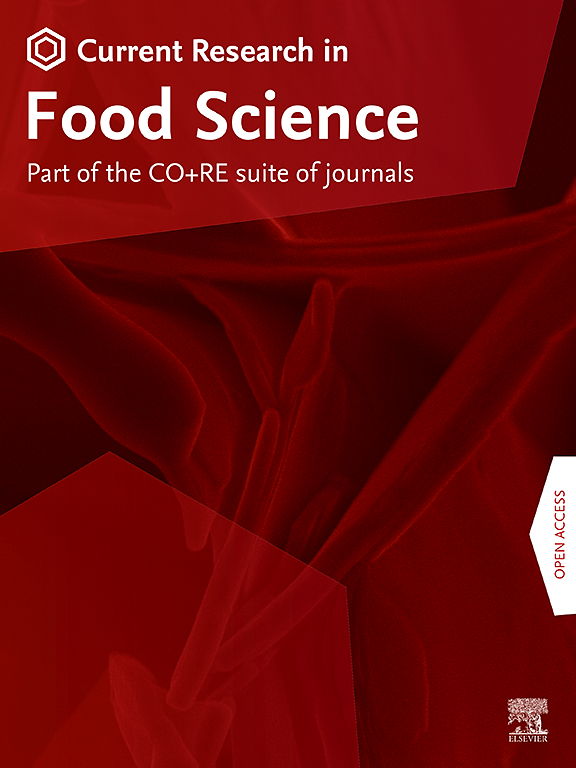Meat analogues: The relationship between mechanical anisotropy, macrostructure, and microstructure
IF 6.2
2区 农林科学
Q1 FOOD SCIENCE & TECHNOLOGY
引用次数: 0
Abstract
Texture of meat analogues is crucial for consumer acceptance, yet it remains poorly defined, but it known that it is influenced by mechanical properties and structure at different length scales. This study describes the relationships between macrostructure, microstructure, and mechanical anisotropy in meat analogues. Two distinct meat analogue product sets are produced with shear cell technology varying in formulations and processing conditions to obtain a wide range of product structures: one based on mung bean protein-rich fractions and the other based on combinations of soy protein isolate and pectin. Mechanical properties are assessed using tensile testing, microstructure is studied using X-ray tomography and confocal laser scanning microscopy, and macrostructure is quantified using a computer vision algorithm based on segmentation and shape features. Both correlation analyses on the response parameters and parameter variance are studied to distinguish the product sets. Strong correlations are found between anisotropy-related parameters, such as fibre score in macrostructure, air anisotropy in microstructure, and the toughness anisotropy index from mechanical properties. Some correlations are found to be product-set independent, such as air bubble anisotropy and fibre score, indicating universal relationships within this study, while other correlations are product-set dependent, such as between fibre score and the anisotropy index of the Young's Modulus in the mung bean fine fraction product set. The relationship between microstructural air bubbles and macrostructure and mechanical properties is apparent in all correlation analyses. Last, univariate feature selection provided insight into which parameters are most important for selected target features.

肉类类似物:力学各向异性、宏观结构和微观结构之间的关系
肉类类似物的质地对消费者的接受度至关重要,但它仍然没有明确的定义,但已知它受到不同长度尺度的机械性能和结构的影响。本研究描述了肉类似物的宏观结构、微观结构和力学各向异性之间的关系。两种不同的肉类模拟产品组合是用剪切细胞技术生产的,在配方和加工条件上有所不同,以获得广泛的产品结构:一种基于富含绿豆蛋白的部分,另一种基于大豆分离蛋白和果胶的组合。通过拉伸测试评估机械性能,使用x射线断层扫描和共聚焦激光扫描显微镜研究微观结构,使用基于分割和形状特征的计算机视觉算法量化宏观结构。研究了响应参数的相关分析和参数方差分析,以区分产品集。与各向异性相关的参数,如宏观结构上的纤维分数、微观结构上的空气各向异性和力学性能上的韧性各向异性指数之间存在很强的相关性。发现一些相关性与产品集无关,例如气泡各向异性和纤维分数,表明本研究中的普遍关系,而其他相关性则依赖于产品集,例如纤维分数与绿豆细粒产品集中杨氏模量的各向异性指数之间。在所有相关分析中,微结构气泡与宏观组织和力学性能之间的关系都是明显的。最后,单变量特征选择提供了对所选目标特征最重要的参数的洞察力。
本文章由计算机程序翻译,如有差异,请以英文原文为准。
求助全文
约1分钟内获得全文
求助全文
来源期刊

Current Research in Food Science
Agricultural and Biological Sciences-Food Science
CiteScore
7.40
自引率
3.20%
发文量
232
审稿时长
84 days
期刊介绍:
Current Research in Food Science is an international peer-reviewed journal dedicated to advancing the breadth of knowledge in the field of food science. It serves as a platform for publishing original research articles and short communications that encompass a wide array of topics, including food chemistry, physics, microbiology, nutrition, nutraceuticals, process and package engineering, materials science, food sustainability, and food security. By covering these diverse areas, the journal aims to provide a comprehensive source of the latest scientific findings and technological advancements that are shaping the future of the food industry. The journal's scope is designed to address the multidisciplinary nature of food science, reflecting its commitment to promoting innovation and ensuring the safety and quality of the food supply.
 求助内容:
求助内容: 应助结果提醒方式:
应助结果提醒方式:


